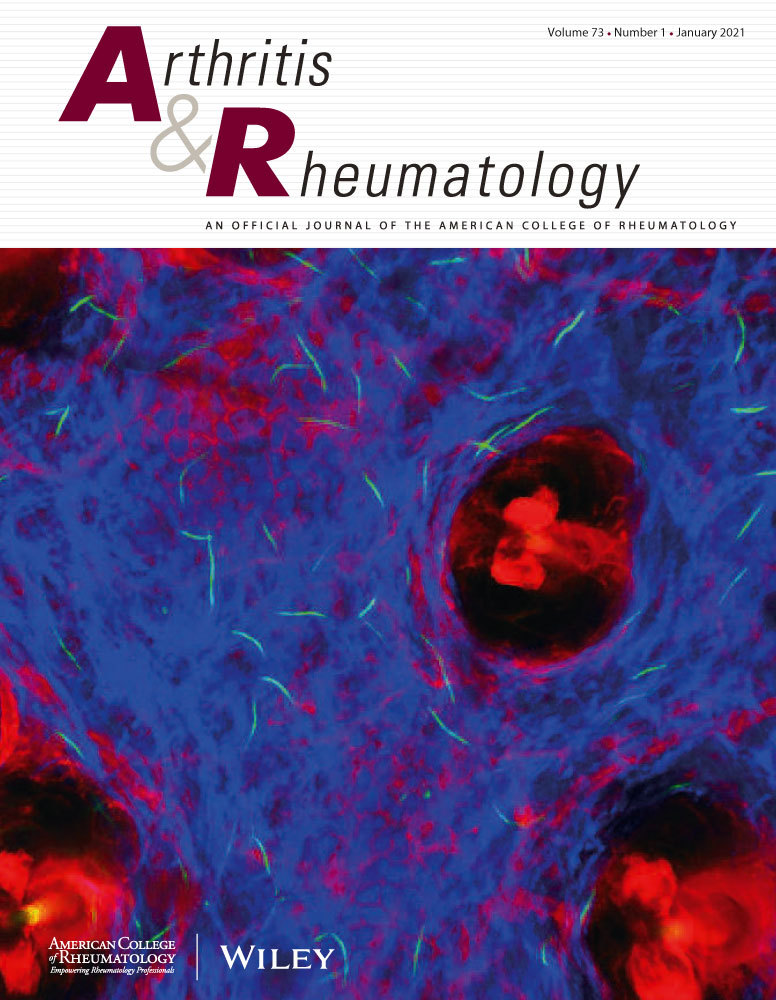几丁质酶3-Like 1通过mTORC1信号通路促进系统性硬化症的内皮向间质转化。
IF 10.9
1区 医学
Q1 RHEUMATOLOGY
引用次数: 0
摘要
目的系统性硬化症(SSc)是一种复杂的自身免疫性结缔组织疾病。内皮-间充质转化(EndoMT)有助于SSc的血管病变和纤维化,但其潜在机制仍有待阐明。本研究确定了几丁质酶3-Like 1 (CHI3L1)在SSc EndoMT中的作用和机制。方法对SSc患者皮肤切片进行免疫染色,检测EndoMT和CHI3L1的表达谱。用重组CHI3L1和抗CHI3L1抗体(CHI3L1 Ab)刺激人脐静脉内皮细胞(HUVECs),探讨CHI3L1对体外培养的内皮细胞(ECs)的影响。在体内,用CHI3L1抗体治疗博来霉素(BLM)诱导的SSc小鼠,研究其对血管病变和纤维化的改善作用。此外,我们还利用蛋白质组学方法探索了CHI3L1诱导内皮细胞内EndoMT的具体机制。结果皮肤切片免疫荧光染色证实SSc患者存在EndoMT及CHI3L1和ECs共定位。随后,CHI3L1被证明可以促进HUVECs中的EndoMT。此外,用CHI3L1 Ab治疗BLM-SSc小鼠显示SSc血管病变和纤维化减轻。从机制上看,CHI3L1介导EndoMT主要是通过与ECs上的CD44受体结合,激活下游AKT/mTOR复合物1 (mTORC1)/S6K信号通路,从而调控EndoMT触发转录因子Snail和Slug。最后,研究表明,雷帕霉素(一种mTORC1抑制剂)可抑制CHI3L1介导的EndoMT过程。结论本研究揭示了CHI3L1在SSc中促进EndoMT的新功能,并强调了CHI3L1作为SSc治疗靶点的前景。本文章由计算机程序翻译,如有差异,请以英文原文为准。
Chitinase 3-Like 1 Promotes Endothelial-to-Mesenchymal Transition in Systemic Sclerosis via mTORC1 Signaling Pathway.
OBJECTIVE
Systemic sclerosis (SSc) is a complicated autoimmune connective tissue disorder. Endothelial-to-mesenchymal transition (EndoMT) contributes to vasculopathy and fibrosis in SSc, yet its underlying mechanism remains to be elucidated. Here, we determined the role and mechanism of chitinase 3-Like 1 (CHI3L1) in SSc EndoMT.
METHODS
Skin sections were immunostained for detecting the EndoMT and the expression pattern of CHI3L1 in patients with SSc. Human umbilical vein endothelial cells (HUVECs) were stimulated with recombinant CHI3L1 and anti-CHI3L1 antibody (CHI3L1 Ab) to explore the effects of CHI3L1 on endothelial cells (ECs) in vitro. In vivo, the bleomycin (BLM) induced SSc mice were treated with CHI3L1 Ab to investigate the improvement of vasculopathy and fibrosis. Furthermore, proteomics was conducted to explore the specific mechanism by which CHI3L1 induces EndoMT in ECs.
RESULTS
Immunofluorescence staining of skin sections confirmed EndoMT and the co-localization of CHI3L1 and ECs in patients with SSc. Subsequently, CHI3L1 was demonstrated to facilitate EndoMT in HUVECs. Furthermore, treatment with CHI3L1 Ab in BLM-SSc mice showed alleviation in SSc vasculopathy and fibrosis. Mechanistically, CHI3L1 mediated EndoMT primarily by binding to the CD44 receptor on ECs, then activating the downstream AKT/mTOR complex 1 (mTORC1)/S6K signaling pathway, thereby regulating the EndoMT trigger transcription factors Snail and Slug. Finally, administration of rapamycin, a mTORC1 inhibitor, has been shown to inhibit the CHI3L1 mediated EndoMT process.
CONCLUSION
This research reveals a new function of CHI3L1 in facilitating EndoMT in SSc and highlight CHI3L1 as a promising therapeutic target for SSc.
求助全文
通过发布文献求助,成功后即可免费获取论文全文。
去求助
来源期刊

Arthritis & Rheumatology
RHEUMATOLOGY-
CiteScore
20.90
自引率
3.00%
发文量
371
期刊介绍:
Arthritis & Rheumatology is the official journal of the American College of Rheumatology and focuses on the natural history, pathophysiology, treatment, and outcome of rheumatic diseases. It is a peer-reviewed publication that aims to provide the highest quality basic and clinical research in this field. The journal covers a wide range of investigative areas and also includes review articles, editorials, and educational material for researchers and clinicians. Being recognized as a leading research journal in rheumatology, Arthritis & Rheumatology serves the global community of rheumatology investigators and clinicians.
 求助内容:
求助内容: 应助结果提醒方式:
应助结果提醒方式:


